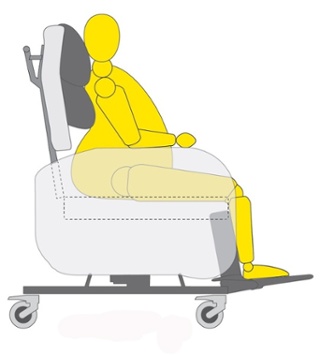TIPS FOR SEATING BARIATRIC CLIENTS
When selecting mobility equipment for bariatric clients, there are a number of specific factors that are important to consider, particularly when it comes to seating. In a recent blog, our friends at Seating Matters outlined the most common mistakes and challenges that healthcare professionals face.
Common Mistakes and Challenges
The most common challenge for clinicians in seating patients with a bariatric condition, is in getting the measurements of the patient correct. This can be often a daunting task and clinicians might require extra help from another clinician to make sure the measurements are as accurate as possible.
A few more of the most common issues are outlined here:
 1. Not Accommodating the Gluteal Shelf
1. Not Accommodating the Gluteal Shelf
Unlike most patients, the gluteal shelf or bulbous gluteal region in bariatric patients, makes it more difficult to give these patients the full back support that they need. The extra tissue in the posterior lumbar region often forces patients to sit forward in their chair, which leaves their back unsupported
2. Incorrect Seat Depth and Seat Height
A patient is more at risk of developing pressure ulcers in interface areas if the seat is not making maximum contact to load the body. Improper loading can lead to an uneven distribution of weight on interface areas. The seat depth and seat height needs to be adjusted to match the patients’ leg length but must be at an appropriate length so as to avoid pulling the patient forward and into a sacral sitting position.
3. No Footplates
On the few bariatric chairs that do have tilt in space, they often do not come with appropriate footplates. 19% of a person’s weight is exerted through the feet in sitting, a key area prone to pressure ulcer development. However, with patients who have a bariatric condition, this percentage can be greater due to the weight of the abdomen resting on the legs. When chairs do not have footplates and are reclined or titled, you are actually increasing the interface pressure instead of decreasing the pressure the patient experiences.
4. Not Accommodating Calves
The correct leg rest and calf pad is an important function to consider in seating patients who have a bariatric condition. With larger calves, there is often increased risk from falls during standing as the feet can be positioned far in front of the patient when the calf pad does not accommodate the mass of the patients’ legs. The leg rest must accommodate larger calves to help maintain a typical 90degree knee flexion posture, and to enable a safe, stable standing position.
5. No Back Angle Recline or Tilt in Space
It is well known that tilt in space can aid repositioning, improve respiration and reduce the risk of pressure ulcers. For patients with a bariatric condition who have decreased mobility and other medical issues, often the need for tilt in space is magnified but many bariatric chairs do not provide this important function.
For more information and advice about seating bariatric clients, get in touch with our mobility equipment specialists by calling 0113 2628000 or emailing enquiries@independencemobility.co.uk